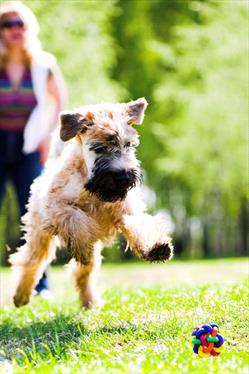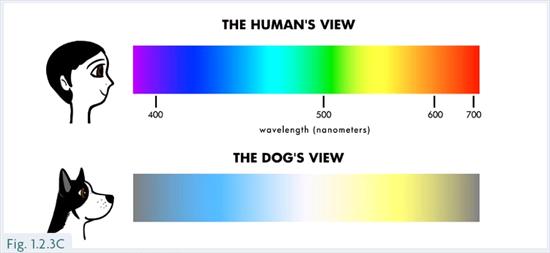Thursdays are always the worst day for little dogs to play fetch at my local park. That’s because mowing is Fridays and on Thursdays the grass is often over one-tennis ball tall. It was on one such Thursday after having to search for my dog’s ball for the third time, that I exclaimed, “It sure would be useful if, instead of being green, this tennis ball were blue and yellow. Then, Jonesy could more easily find it himself.” Well, a passing pet owner quickly corrected me. “That wouldn’t help. Dogs are color blind.”
For a second I thought, Duh, that’s right. Dogs don’t see color the way we do. But then I remembered that they can distinguish blue from yellow. That’s because while dogs can’t see all of the colors we can, they can perceive some differences.
While humans have three types of photoreceptors in their eyes that transmit signals about color to the brain, dogs have two types of photoreceptors. We know that these photoreceptors work to transmit information allowing dogs to perceive differences in color because dogs have told us so. Well, sort of.
Illustrations by Lili Chin.
How Have Dogs Told Us That They Perceive Color?
To determine whether dogs can see color, researchers taught dogs to pick the odd-colored circle out of a choice of three circles. So if they showed colors that the dogs could not distinguish, they would fail at the task, but if they chose colors that the dogs could tell apart, the dogs would perform consistently well. Of course. the researchers did also consider that the hue or brightness might be a distinguishing cue, so they systematically tried patches of different brightness too.
Dr. Gerold Jacobs, Professor of Psychology at the University of Santa Barbara, who lead much of this color vision research in dogs, is careful to point out that while we cannot determine exactly what the dog perceives the color to be, we think what we see as red, orange, yellow or green appears as different saturations of yellow to a dog, while blue-green, blue and violet appear as different saturations of bluish gray.
Photos courtesy of Gerald Jacobs, Professor of Psychology, University of California, Santa Barbara
What Colors Do Dogs Distinguish Best?
Back to the dilemma of the tennis ball in the tall grass. Yes, if the balls were two-tone blue and yellow, Jonesy might be able to find them a little better. Overall, if we want dogs to distinguish between colors, the best colors to use are blue and yellow. On the other hand, maybe if the ball was just blue or violet or bigger, that would be good enough. I’m too lazy to actually test it out. I’ll just bring extra tennis balls.
Photo courtesy of Dr. Cynthia Cook of Veterinary Vision, Inc. Animal Eye Specialists (www.veterinaryvision.com)
For more information on canine vision, read Perfect Puppy in 7 Days.






